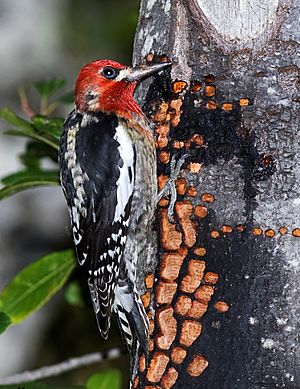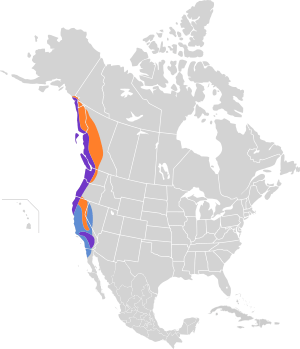Red-breasted sapsucker facts for kids
Quick facts for kids Red-breasted sapsucker |
|
|---|---|
 |
|
| Conservation status | |
| Scientific classification | |
| Genus: |
Sphyrapicus
|
| Species: |
ruber
|
 |
|
The red-breasted sapsucker (Sphyrapicus ruber) is a medium-sized woodpecker. It lives in the forests along the west coast of North America.
Contents
About the Red-Breasted Sapsucker
These birds have a bright red head and upper chest. Their lower belly and rump are white. Their back and wings are black with stripes. They also have a large white patch on their wings.
Red-breasted sapsuckers build their nests inside holes in trees. Birds living in the northern parts of their range migrate south for winter. However, those living along the coast often stay in the same area all year.
Like other sapsuckers, these birds drill holes in trees. They eat the tree sap that flows out. They also eat insects that are attracted to the sap. Sometimes, they catch insects while flying. They also enjoy eating seeds and berries.
Where Sapsuckers Live
Red-breasted sapsuckers live and raise their young from southeast Alaska and British Columbia. Their home range goes south through the Pacific Coast Ranges in western Washington, Oregon, and northern California.
They usually live in forests with trees like pine, hemlock, Douglas-fir, fir, and spruce. But they can also be found in other types of woodlands.
Sapsucker Migration
The sapsuckers that live in the northern areas fly south for the winter. Birds that live inland or in higher places often move to warmer coastal areas. Their winter homes can be in forests with trees that lose their leaves or trees that stay green all year. This bird's winter range reaches as far south as Baja California in Mexico.
Sapsucker Habits and Diet
Red-breasted sapsuckers prefer older forests. They need living trees to get the sap they eat.
How Sapsuckers Eat
A sapsucker's tongue is special. It has stiff hairs that help it collect sap. Red-breasted sapsuckers visit the same tree many times. They drill neat rows of holes in the tree. The bird will leave and come back later when the sap has started flowing.
Visiting the same tree over and over can sometimes even kill the tree. Insects are also attracted to the sap. The sapsuckers eat these insects too. Other birds, like rufous hummingbirds, sometimes follow sapsuckers to also get food from the sap holes.
Sapsucker Sounds and Behavior
These birds make many different noises. Their calls include chattering, squeals, and sounds like screams. They also drum with their bills on different surfaces. Many of these sounds help them mark their territory and find a mate. They also make noise when drilling holes for food and building their nests.
Sapsucker Life Cycle
The red-breasted sapsucker starts making its nest hole in a dead tree, usually in April or May. They have one group of babies each year. The female bird lays 4 to 7 pure white eggs.
Both parents feed the young birds. The baby birds leave the nest when they are 23 to 28 days old. They do not use the same nest hole again.
Images for kids
See also
 In Spanish: Chupasavia Pechirrojo para niños
In Spanish: Chupasavia Pechirrojo para niños






